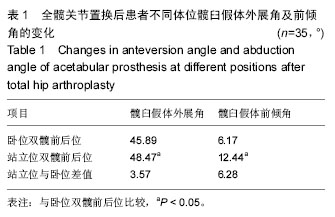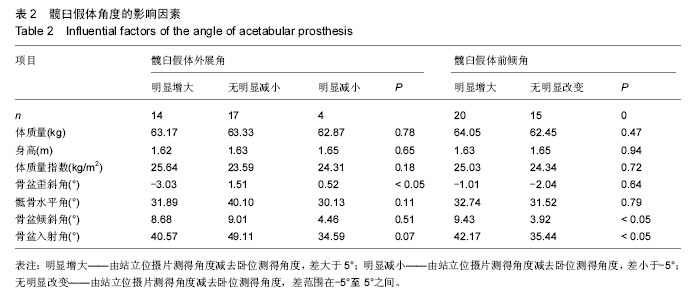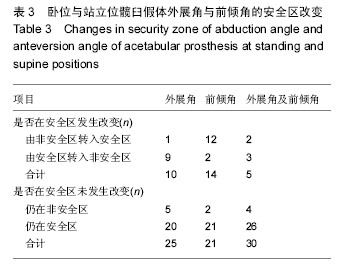| [1] Barrack RL,Lavernia C,Ries M,et al.Virtual reality computer animation of the effect of component position and design on stability after total hip arthroplasty. Orthop Clin North Am.2001;32(4):569-577.
[2] Kennedy JG, Rogers WB,Soffe KE,et al.Effect of acetabular component orientation on recurrent dislocation, pelvic osteolysis, polyethylene wear, and component migration.J Arthroplasty. 1998; 13(5): 530-534.
[3] 翟吉良,蔡思毅,翁习生.人工全髋关节置换术后脱位原因分析[J].中国矫形外科杂志,2013,21(1):58-60.
[4] Lazennec JY,Charlot N,Gorin M,et al.Hip-spine relationship: a radio-anatomical study for optimization in acetabular cup positioning.Surg Radiol Anat.2004; 26(2): 136-144.
[5] Zilber S,Lazennec JY,Gorin M,et al.Variations of caudal, central, and cranial acetabular anteversion according to the tilt of the pelvis.Surg Radiol Anat.2004; 26(6): 462-465.
[6] 吴坚,吕明,柳剑,等.不同X线方法计算髋臼杯前倾角的准确性和可靠性研究[J].中国矫形外科杂志,2013,21(14): 1427-1434.
[7] 许杰,马若凡,丁悦,等.骨盆体位性角度变化三维监测对髋关节置换的临床意义[J].岭南现代临床外科,2008,8(6): 460-462.
[8] Pradhan R.Planar anteversion of the acetabular cup as determined from plain anteroposterior radiographs. The Journal of bone and joint surgery.J Bone Joint Surg Br.1999;81(3):431-435.
[9] Daly PJ,Morrey BF.Operative correction of an unstable total hip arthroplasty. J Bone Joint Surg Am. 1992; 74(9): 1334-1343.
[10] Callanan MC,Jarrett B,Bragdon CR,et al.The John Charnley Award: risk factors for cup malpositioning: quality improvement through a joint registry at a tertiary hospital.Clin Orthop Relat Res.2011;469(2):319-329.
[11] Polkowski GG,Nunley RM,Ruh EL,et al.Does standing affect acetabular component inclination and version after THA.Clin Orthop Relat Res.2012;470(11): 2988-2994.
[12] Poddubnyy D,Rudwaleit M,Haibel H,et al.Effect of non-steroidal anti-inflammatory drugs on radiographic spinal progression in patients with axial spondyloarthritis: results from the German Spondyloarthritis Inception Cohort.Ann Rheum Dis. 2012; 71(10):1616-1622.
[13] Hamersma J,Cardon LR,Bradbury L,et al.Is disease severity in ankylosing spondylitis genetically determined. Arthritis Rheum.2001;44(6):1396-1400.
[14] Lewinnek GE,Lewis JL,Tarr R,et al.Dislocations after total hip-replacement arthroplasties.J Bone Joint Surg Am.1978;60(2):217-220.
[15] Lazennec JY,Rousseau MA,Rangel A,et al.Pelvis and total hip arthroplasty acetabular component orientations in sitting and standing positions: measurements reproductibility with EOS imaging system versus conventional radiographies.Orthop Traumatol Surg Res.2011;97(4):373-80.
[16] Parratte S,Pagnano MW,Coleman-Wood K,et al.The 2008 Frank Stinchfield award: variation in postoperative pelvic tilt may confound the accuracy of hip navigation systems.Clin Orthop Relat Res.2009; 467(1):43-49. |
.jpg)



.jpg)
.jpg)
.jpg)
.jpg)